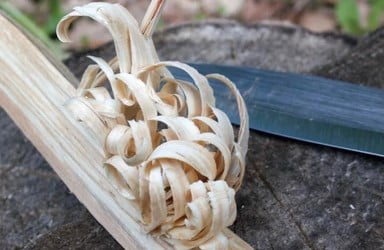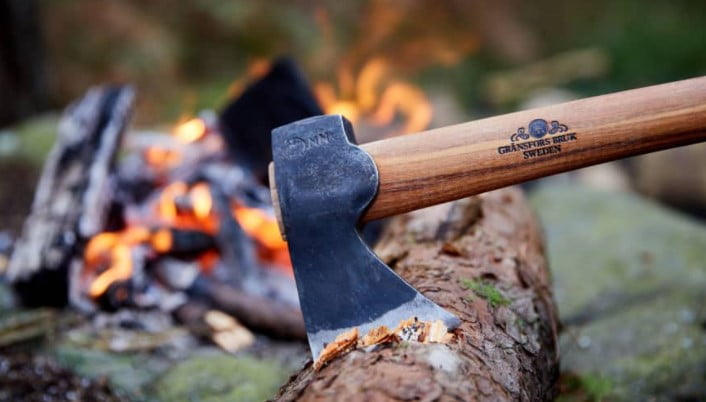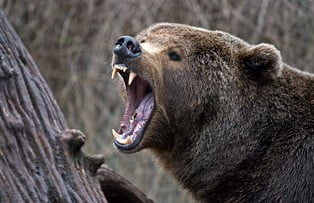A camp axe is a small to mid-sized axe that you can use for a specific purpose in any outdoor scenario, but more specifically camping. This small but versatile cutting tool is probably the most useful piece of equipment in your camping arsenal… you just don’t know it yet!
A camp axe can also be known as a survival axe, bushcraft axe or hatchet, and is an essential tool for the outdoors due to the amount of tasks that a camp axe can perform.
Compared to a knife or a machete – which also may be included in your kit – you can use a camp axe to gather and prepare firewood far more effectively. You can also chop and shape wood to construct a bigger, better and sturdier shelter compared to a knife or a machete for example.
Having a camp axe will help improve your self-sufficiency in any outdoor scenario. When faced with a survival situation, a camp axe can be a life-saver, and it will make your camping experience hassle-free and enjoyable.
TABLE OF CONTENTS:
What is a camp axe used for
A camp axe is a universal outdoor tool for multiple outdoor uses. I have lost count of the number of tasks a good camp axe can perform. Here are some of the many uses for a camp axe:
Chopping wood
Obvious I know, but when you are out camping, your camp axe will be the main instrument for chopping down trees or limbs that you can use to set up camp.
A strong and durable camp axe makes things so much easier around the campsite. Couple this with a good folding saw and you have all you need to be efficient in any camping scenario.
Related Article: Top 5 Best Silky Folding Saws – For Camping, Bushcraft And Backpacking
Splitting kindling
For light jobs such as kindling for firewood prep, the camp axe is ideal. Working around the edges of a small log with your camp axe is by far the easiest method for harvesting kindling quickly.
The beauty of a camp axe as a cutting tool is having a razor-sharp cutting edge with the weight of the steel head to power through wood easily.
Creating tinder
To get a fire going you’ll need something smaller than kindling to start with. The sharp edge of a good quality camp axe should be sharp enough to shave the hairs off your arm – it’ll make short work of feathering some tinder from a nearby stick.
Simply shave down the length of the wood to produce some fine tinder to set a spark to.
Carving
Things like spears or stakes are a necessity in the wild and can be used for so many purposes. Even around camp, carving simple stakes can help with erecting tents, sturdy tripods for cooking, or carving feather sticks. This can greatly increase your success in starting a fire in any weather.

A feather stick is any nearby stick that has been shaved with your camp axe to produce thin feathers of dry wood that increases the surface area of the wood to assist fire starting. This is tricky at first but it’s an essential carving skill for the outdoors that gets easier with practice.
Once you get proficient at carving with your camp axe, why not advance to carving a spoon or bowl… or some extravagant masterpiece!
Driving tent stakes
A camp axe can easily double as a hammer if you flip it round and use the poll end. Ideal for hammering in tent stakes or any other job where a hammer is required. Just don’t use the poll against another steel surface because you’ll damage your camp axe.
Building a shelter

Constructing a simple lean-to shelter is easy with a good quality camp axe. You’ll need to limb some strong branches to build the frame which requires a sharp cutting edge with some chopping power. A saw would be just as useful here but not half as much fun!
Snow and ice tool
If you live someplace where there is snow and ice, a camp axe will come in really handy. Having a small chopping tool to break up blocks of ice is far easier than chipping away with a pick. Also handy for making a hole for ice fishing.
Felling small trees
Although felling large trees is best left to a bigger axe, a good quality camp axe will handle small diameter trees easily (up to 5 inches). Just chop into the tree on the diagonal as you move around in a circle removing pieces until its done.
Cleaning up limbs

Once a tree is felled the limbs are removed for a variety of purposes; building material, firewood etc. You wouldn’t use your felling axe for this purpose. A good sharp camp axe is ideal for limbing branches off felled trees in an efficient manner.
Limbing branches of rooted trees is also required on occasion. Maybe a tree in your garden needs a few branches removed to tidy it up or to create space. All you need is a quality camp axe for the job.
Processing game or fish
As vital a knife is in the hunting environment, you’re gonna need a cutting tool with a bit more power for splitting pelvis, ribcage, backbone, neck, etc. of your game.
There are so many tasks involved in processing game; a camp axe provides a razor-sharp cutting edge for slicing and skinning, while the chopping ability deals with the tougher tasks.
Throwing!
Have you heard about the current trend in axe throwing parties? It’s a big thing at the moment. A group of friends get together to throw hatchets at wooden targets while drinking beer! What’s not to like?
It’s also good to practice this in the field, just for fun. See if you can throw your camp axe and stick it in a nearby tree trunk – Safety first, obviously!
Self defence (In the wild)

For the survivalists among us. You never know when you’re safety could be threatened by unwanted visitors in the wild. Heaven forbid some wild animal takes a fancy to you – dispatch it (with love) by means of your trusty camp axe!.. Or, just run away!
Slicing (knife jobs)
Anything a knife can do, a good quality camp axe can do the same. Camp axes should be kept razor-sharp – sharp enough to shave the hair off your arm, so should easily cope with any knife job you can think of.
The advantage of a camp axe is having the razor-sharp blade attached to a tool that is capable of slicing & skinning as well as chopping.
Campsite food prep
A camp axe’s versatility doesn’t stop at bushcraft. After a hard days toil in the wilderness building your shelter and hunting game or fishing in the river, simply clean up your camp axe and get to work preparing dinner. No need for kitchenware when your in the wild!
Digging
There may be times you need to dig holes for fires or just to loosen earth to assist with shelter building or trap making. With limited tools to hand your camp axe can be used to do this quite easily. It has the weight and swinging power to make short work of digging a few holes – Just be sure to hone the edge again once you’re done so it’s always ready for action.
Do I need an axe for camping?
Well no, you don’t NEED an axe for camping… but it makes life a whole lot easier. And it’s fun having an axe around the campsite! A camp axe is one of those tools that you wonder how you got along without one before.
If you are interested in getting a camp axe – which I assume you are since you’re reading this – just get yourself a cheap one to begin with, give it a go. Chop things, carve something, kindle some wood, make a basic shelter or just throw the damn thing at a tree for fun!
Once you see how versatile a camp axe can be for the outdoors, you can upgrade to something a bit better.
Top tip: Cheap axes are cheap for a reason – they wont stay sharp for long and won’t stand up to any serious chopping… or they will just break!
What should I look for in a camp axe?
When you are purchasing an axe for camping, there are factors that you should consider to ensure you get the best value for your money. Here are a few pointers when purchasing a camping axe:
Material
The material used to construct the axe head and the shaft is very important. This is because the construction material will determine the camp axe durability. The construction material should be of sufficient quality to prevent chips, dings or general dulling of the cutting edge.
Therefore, when buying a camp axe, you should go for a high carbon steel head whenever possible. This will ensure it retains its sharpness for extended periods before re-sharpening is required.
The handle of the camp axe should be wood – ideally hickory or ash – with a protective coating to ensure it is protected from the elements and has sufficient grip. Wooden handles are also easier to replace if it becomes damaged or overly worn.
Synthetic handles can be durable and lightweight too but nothing really feels quite like a classic wooden handle.
The shape of the head
Axe heads come in different shapes. The different head shapes are designed for specific purposes. A camping axe should have a flat poll for you to use as a hammer for camping.
The blade should curve downward to prevent it from getting stuck in the wood and to allow you to rock it back and forth when chopping wood.
Shape and size of the handle
Longer axe handles are necessary for felling trees or splitting large pieces of wood. Camp axes should be between 14 and 19 inches on average. These are hatchet sizes axes that are easier to carry, provide more precision when chopping and can be one or two-handed depending on the shaft length.
The sharpness of the edge
The sharpness of the camp axe indicates its quality. The sharper the camp axe, the cleaner the cut you will get when chopping. A dull camp axe – or any axe – is a nightmare. You might as well buy a hammer, because all you’ll be doing with a blunt blade is bludgeoning the wood to death for hours!
This is where a good quality camp axe differs from a cheap, hardware store axe. Only high quality, forged steel can retain a razor sharp blade. Cheap steel will become dull very quickly due to the low carbon content and low quality craftsmanship.
Quality of the sheath
A camp axe is – or should be – a sharp cutting tool, and once it is stowed away, it should remain safe and secure. Therefore, when purchasing a camp axe, you should avoid the ones with a nylon sheath.
Ensure the sheath of your camp axe is made of leather to cover its head and keep its edge safe. Additionally, the sheath should have a sturdy loop for easy attachment of the camp axe around your belt or pack.
Weight
The weight of the camp axe determines its agility. A good quality camp axe should be precisely balanced for the delivery of powerful, accurate, and efficient strokes to enable it to cut through the wood faster while reducing the risk of injury that may occur via ‘bounce back’.
Camp axes you might love…
Check out the full range of camp axes on Amazon
Conclusion
Camp axes come in various sizes, shapes and levels of craftsmanship. For camping purposes, a full size felling axe is definitely not required. I would always recommend a hatchet for camping.
If you are interested in some further reading and in-depth reviews, take a look at my buyers guides for best camping hatchets below.




Leave a Reply